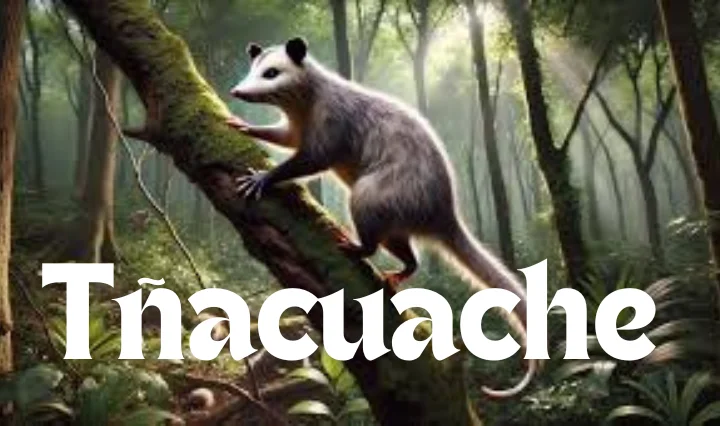Introduction
The tñacuache, known scientifically as the opossum, is a fascinating marsupial native to the Americas. Recognized for its distinct appearance and behaviors, the tñacuache plays a crucial role in its ecosystem. In this comprehensive guide, we will delve into the characteristics, habitat, diet, myths, and ecological importance of the tñacuache, highlighting why this unique creature deserves our attention and protection.
What is a Tñacuache?
The tñacuache is the only marsupial found in North America, primarily inhabiting the United States, Mexico, and parts of Central America. Its scientific name is Didelphis virginiana.
Physical Characteristics
The tñacuache is easily identifiable due to its unique physical features:
- Size and Weight: Adults typically weigh between 4 to 14 pounds and measure 24 to 40 inches long, including their tail.
- Fur: The tñacuache has a grayish-white coat with a lighter underbelly, which helps it blend into its surroundings. Its fur is coarse, offering protection from the elements.
- Face and Ears: The tñacuache has a long, pointed snout and large, rounded ears that are sensitive to sounds, allowing it to detect predators and prey easily.
- Tail: Its long, naked tail is prehensile, meaning it can grasp objects, which aids in climbing and balancing while navigating through trees and shrubs.
- Teeth: With 50 teeth, the tñacuache has the most teeth of any land mammal in North America, which helps it consume a wide variety of foods.
Distinctive Features
- Opposable Thumb: The tñacuache has an opposable thumb on its hind feet, allowing it to grip branches and manipulate food.
- Eyesight: While their eyesight is not the best, they have excellent senses of smell and hearing, making them adept at locating food in the dark.
Habitat and Distribution
The tñacuache is highly adaptable and can thrive in a variety of habitats. Its range extends from southern Canada through the United States to central Argentina, making it one of the most widespread marsupials in the Americas.
Preferred Habitat
Tñacuaches are commonly found in:
| Habitat Type | Characteristics |
|---|---|
| Forests | Dense tree cover, ample food sources, and shelter from predators. |
| Wetlands | Rich in biodiversity, providing both food and water sources. |
| Urban Areas | Proximity to human settlements offers easy access to food, especially garbage. |
Behavior and Diet
Nocturnal Lifestyle
Tñacuaches are primarily nocturnal, meaning they are most active during the night. This behavior helps them avoid predators and find food when other animals are less active.
Diet
As omnivores, tñacuaches have a diverse diet that includes:
- Fruits: Apples, berries, and various other fruits that provide essential vitamins.
- Vegetables: Corn, carrots, and garden waste are commonly consumed.
- Insects: Beetles, crickets, and earthworms make up a significant portion of their diet.
- Small Animals: They occasionally prey on small mammals, birds, and their eggs.
- Carrion: Tñacuaches play a vital role in the ecosystem by eating dead animals, which helps prevent the spread of disease.
Feeding Habits
- Opportunistic Feeding: Tñacuaches will eat whatever food is available, which allows them to thrive in various environments.
- Foraging Techniques: They use their keen sense of smell to locate food and are known to scavenge human trash for leftovers.
Unique Adaptations
One of the most intriguing behaviors of the tñacuache is its ability to play dead when threatened. This remarkable defense mechanism, known as thanatosis, is an effective strategy to avoid predation.
Defense Mechanisms
- Playing Dead: When threatened, the tñacuache can fall over, go limp, and emit a foul odor that resembles a dead animal. This reaction can confuse predators, causing them to lose interest.
- Hissing and Teeth Display: If cornered, tñacuaches may hiss, growl, or show their teeth to appear more intimidating.
Myths and Misunderstandings About Tñacuaches
Despite their unique qualities, tñacuaches are often misunderstood, leading to several myths. Here are some common misconceptions:
- They Are Dirty Animals: Many people perceive tñacuaches as dirty because they rummage through garbage. However, they are actually clean animals and prefer to keep their living spaces tidy.
- Tñacuaches Are Dangerous: There is a misconception that tñacuaches are aggressive. In reality, they are generally docile and prefer to avoid confrontation. They are more likely to flee or play dead when threatened.
- They Carry Diseases: While all wild animals can carry diseases, tñacuaches are not significant carriers of rabies. Their body temperature is typically lower than that of other mammals, making it difficult for the rabies virus to survive.
- Tñacuaches Are Pests: Although they may raid trash cans, tñacuaches are beneficial to the environment. They control insect and rodent populations and help decompose dead animals.
- Tñacuaches Can Hang by Their Tails: Contrary to popular belief, tñacuaches do not hang by their tails. Their tails are prehensile, allowing them to grasp objects, but they are not strong enough to support their entire body weight.
Understanding these myths helps foster a more accurate view of tñacuaches, encouraging respect and protection for these unique creatures.
Importance to the Ecosystem
The tñacuache is an essential part of its ecosystem, contributing to ecological balance in several ways:
Ecological Benefits
| Benefit | Description |
|---|---|
| Pest Control | By consuming insects and small rodents, they help keep these populations in check. |
| Seed Dispersal | Tñacuaches consume fruits and excrete seeds, aiding in plant reproduction and diversity. |
| Waste Reduction | By eating carrion, they help decompose dead animals and reduce the risk of disease. |
Contributions to Biodiversity
The presence of tñacuaches in an ecosystem supports overall biodiversity by promoting healthy plant growth and controlling pest populations.
Conservation Status
Currently, the tñacuache is not considered endangered. However, it faces several threats, including:
- Habitat Loss: Urbanization and deforestation can lead to the destruction of natural habitats.
- Road Mortality: Many tñacuaches are killed by vehicles while crossing roads, particularly in suburban areas.
Conservation Efforts
To protect tñacuaches, several initiatives can be undertaken:
- Habitat Preservation: Protecting forests and wetlands where tñacuaches thrive is crucial.
- Public Awareness Campaigns: Educating communities about the importance of tñacuaches can foster appreciation and support for their conservation.
Conclusion
The tñacuache is a remarkable marsupial that plays a vital role in maintaining ecological balance. Its unique characteristics and behaviors highlight the diversity of wildlife in the Americas. By understanding the significance of the tñacuache, we can appreciate its value and take action to protect its habitat. Awareness and conservation efforts are essential to ensure that future generations can enjoy the presence of this incredible creature in our ecosystems.
Related Article: Slayunny2: A Comprehensive Look at the Emerging Digital Creator
FAQs About Tñacuaches
1. What is a tñacuache?
A tñacuache, also known as the opossum, is a marsupial native to the Americas. It is the only marsupial found in North America and is known for its unique appearance and nocturnal behavior.
2. Where can tñacuaches be found?
Tñacuaches are widely distributed across the Americas, primarily found in the United States, Mexico, and Central America. They thrive in various habitats, including forests, wetlands, and urban areas.
3. What do tñacuaches eat?
Tñacuaches are omnivores, meaning they eat a variety of foods, including fruits, vegetables, insects, small animals, and carrion. Their diverse diet helps them adapt to different environments.
4. Are tñacuaches dangerous?
No, tñacuaches are generally not dangerous. They are shy creatures that prefer to avoid confrontation. When threatened, they often play dead rather than attack.
5. Do tñacuaches carry diseases?
While all wild animals can carry diseases, tñacuaches are not significant carriers of rabies. Their body temperature is usually lower than that of other mammals, making it difficult for the rabies virus to survive.






